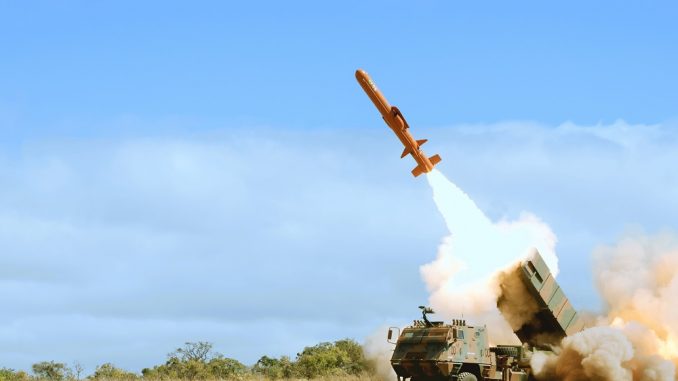
The latest conflicts have demonstrated once again the need to have modern rocket launcher systems capable of defeating concentrations of forces, neutralizing or prohibiting the use of armored or mechanized forces, carrying out counter-battery fires, preventing the use of anti-tank and anti-aircraft defenses or carrying out concealment or blinding fires. Unfortunately, Spain after the loss of Teruel has not been able to acquire a replacement, a decision that cannot be delayed any longer.
A rocket is a self-propelled projectile that obtains its thrust from the reaction of the rapid expulsion of combustion gases from a rocket motor. Generally, they use solid fuel and can mount warheads of any type (high explosive, breaker, thermobaric, incendiary, cluster with different submunitions or anti-tank mines, anti-bunker, etc.). They follow a ballistic trajectory, although there are models equipped with a terminal guidance system (inertial, satellite, GPS, trajectory correction...) that, through the corresponding fins, modify the direction in the final phase of their journey to head towards the target. , which they attack with great precision.
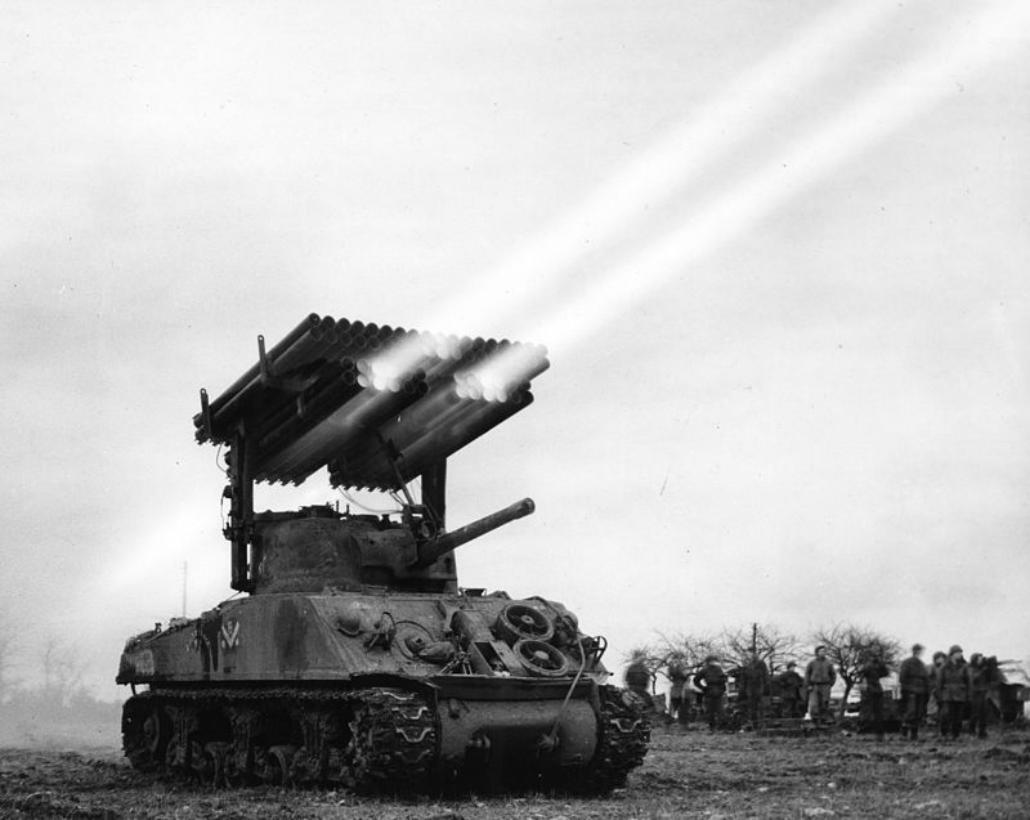
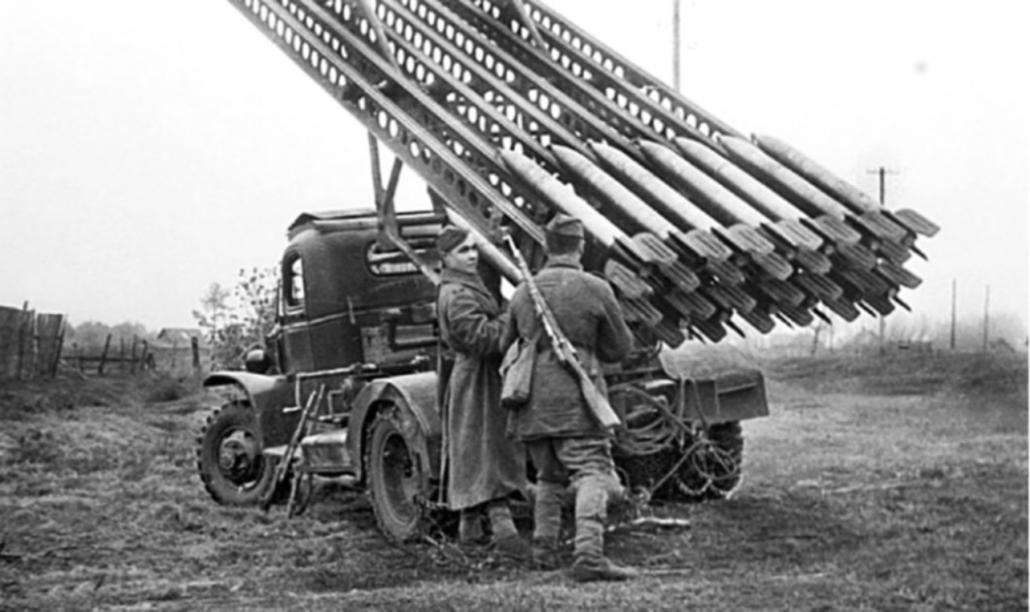
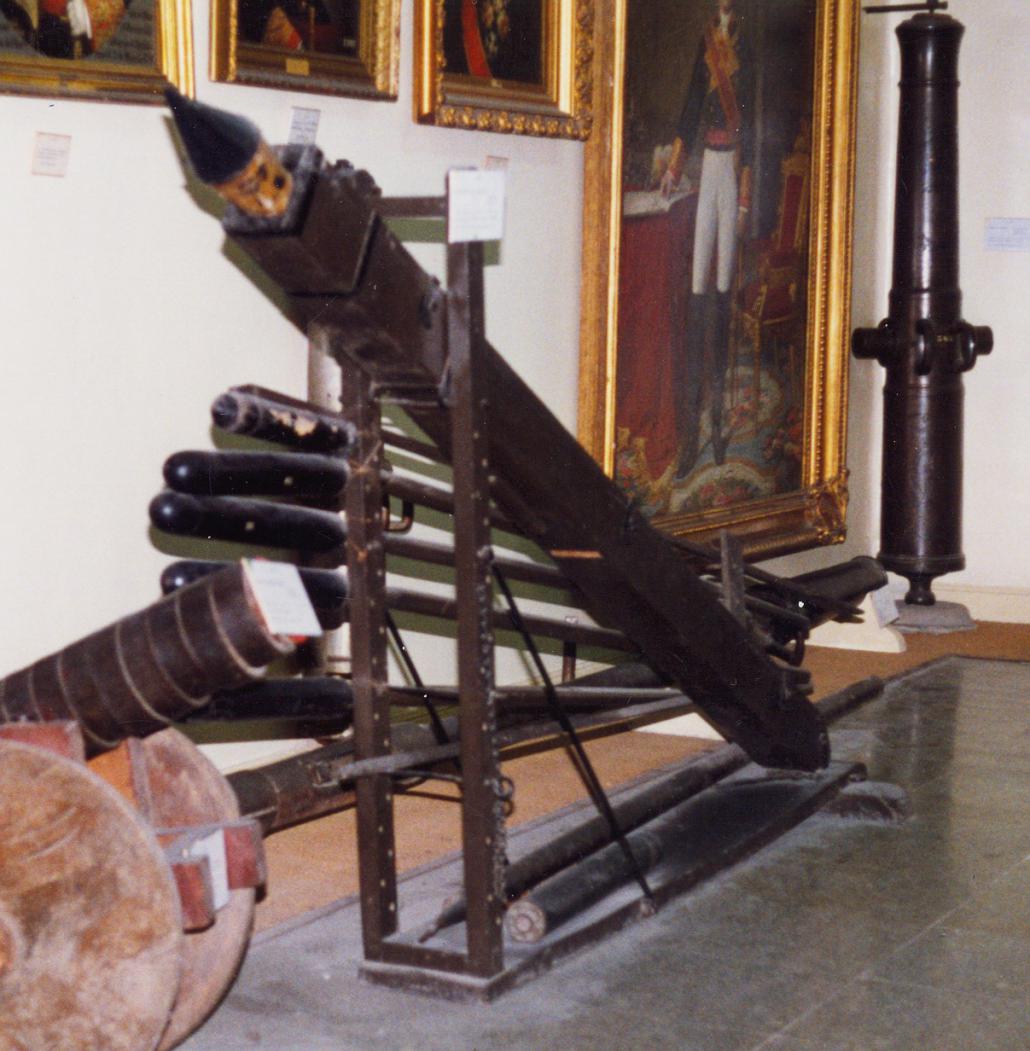
Origin of rockets
Chinese flying fire arrows are the oldest rockets of which we have evidence, being used in the defense of the city of Kai Fung Fu against the Mongols (1232) and, two years later, against the Tatars. From then on, there are numerous references to their use both by the Chinese and other peoples, among which the Mongols, the Koreans and the inhabitants of Timor stand out, who used them against the Indians in 1399. In general terms, They were long bamboo arrows that had a rocket tied to the front, being launched from wooden or bamboo arrows, some equipped with wheels. In addition, both the Chinese and the Koreans built examples with supports for a large number of arrows, that is, something similar to today's multiple rocket launchers. In some Chinese drawings, multiple and portable launchers can be seen that were aimed at esteem (they were called hwach), so it can be assumed that their effectiveness must have been more psychological than anything else.
Although on a purely anecdotal level, I think it is worth reviewing two models of Chinese rockets: The Bird and the Fire Dragon. The first was called that because it had two wings similar to those of a bird, while the second, designed to be launched from the water, was reminiscent of that mythological animal and had several propellant rockets that came into operation successively, so We can consider it the first two-stage rocket in history, with an estimated range of about 1.600 meters.
The Arabs introduced the so-called Chinese arrows to Europe, which were launched during the siege of Valencia in 1288, and were used very sporadically from then on. According to Clonard, an anonymous chemist describes those weapons in the following way: "The rocket will be fitted with a straight and very light rod that is twice as long or slightly more than the length of the tube in order to serve as a rudder when it is launched." Shoot in one direction, either up or to the sides, as appropriate. Then place the tube on a support, like the arrow in the crossbow, and with such support it can be fired. The trestle on which the tube is to rest will be arranged so that it has a channel, in which it is adjusted; The part of the rod will be inserted in a device perforated along its entire length, like a cane, so that it can all fit into the hole and be given the desired direction...
If you want to wreak havoc on the enemy with this rocket, put some solid material inside, such as sulfur, stones or pitch, and throw it at the desired point and it will burn. If you want the shot to make a lot of noise and be heard from a distance, put small cartridges in the rocket, which will ignite more slowly and the noise will last longer.
Given the low efficiency of the rockets of that time, for their use to become widespread in the West, it was necessary to wait until the beginning of the 19th century, with the entry into service of the models of the Englishman William Congreve, equipped with an elongated rod initially mounted on a side, which served to maintain direction. Its development benefited from the use of the models used against the British by the troops of the Indian Sultanate of Mysore, thanks to which they achieved some notable victories.
While the first models were launched from simple easels, the introduction of the central rod allowed the adoption of metal tubes, which increased their precision. Furthermore, as a logical consequence, various multi-tube field mounts appeared, which generally had 8 copper tubes, studying other variants such as the one proposed by the Marquis of Viluma with 10 tubes placed in two rows. In Spain, although it is not Attributed excessive importance to them, some tests were also carried out with rockets starting in 1817, notably those carried out in Cuba in 1832, with 6- and 3-pound shrapnel versions, although the results were not encouraging at all. In fact, although they were used in operations in Navarra (1835) and in Morocco (1859), the truth is that they never reached an acceptable development, although, in certain quantities, various models were manufactured, largely derived from the designs by Congreve.
Already in 1844, William Hale modified the design of rockets by placing several inclined motors that rotated them during flight, which considerably increased their precision and made the use of the rod unnecessary. This fact favored the use of rockets which, despite everything, did not become widespread due to the increase in firepower and precision of classical artillery. Consequently, we had to wait until WWII for rockets to undergo their definitive boom with the massive use, above all, of the German Nebelwerfer or the Soviet Katiushas or Stalin organs, although the Americans also used the T-34 Sherman. Calliope and the Canadians the Land Mattress, of smaller calibers. Of all of them, the German models were the most varied both due to the platforms and configurations adopted, as well as their caliber, since there were versions from 80 to 380 cm of the rocket launched by the Sturmtiger. As interesting data, the Germans used a model to be launched from aircraft (Werfergranate 21), and the Allies also often used them to hit ground targets from the sides of ships, especially in the Pacific.
Currently, every self-respecting Army has rocket launcher units, basically equipped with multiple self-propelled launchers, mounted on trucks or on wheeled or tracked armored vehicles, although there are also numerous models of single or multiple launchers on trailers, or to be installed on light vehicles. .
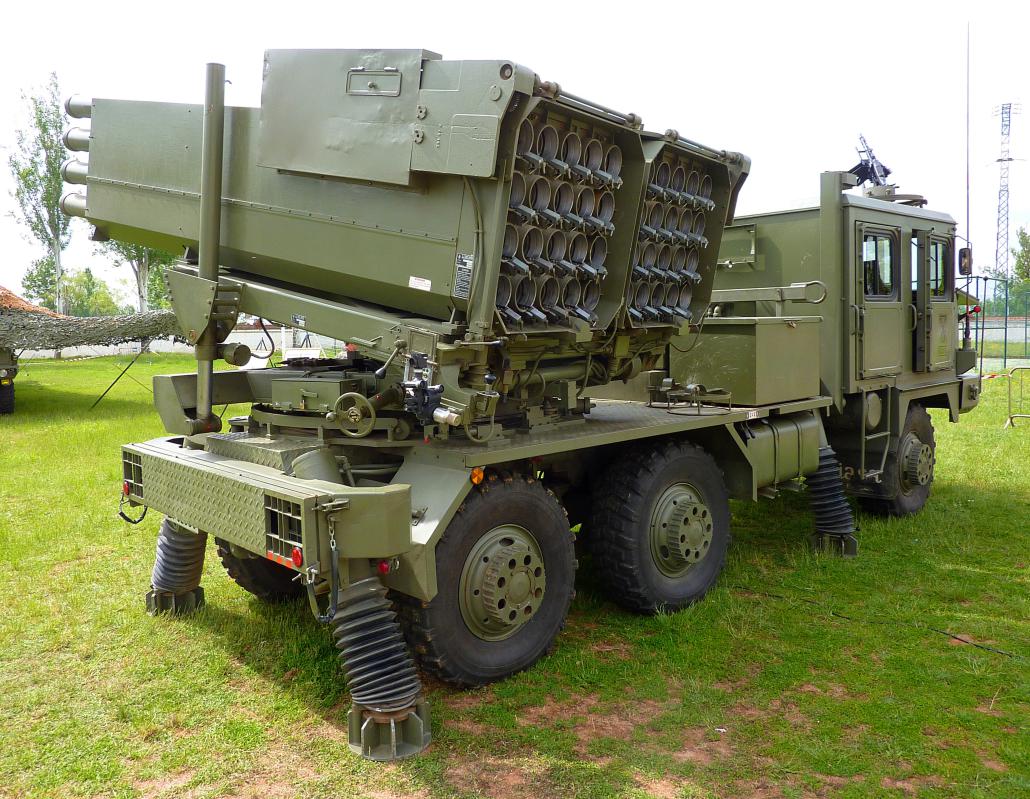
Modern rocket launchers in the Army
In the 50s, the Rocket Studies Center was organized, beginning the design of some systems that, in the end, culminated in the development of the Teruel. But, first, several types of rockets and their corresponding launchers had to be built and tested, which, after the creation of the Rocket Launcher Regiment in Astorga, in 1960, were delivered for use and experimentation. Just as a curiosity, we can mention that rockets of very different calibers were made (108, 216, 300 mm...) that were installed in cage-type launchers with different alveoli (1, 4, 6, 8, 10, 18, 20, 21 , 32, etc). Furthermore, examples as diverse as a Stürmgestchutz III tracked chassis, a small two-wheeled trailer, Reo trucks, Dodge WC-51, Barreiros Comando 4×4 and Panther 6×6, Pegaso 3045… and even , a towed gondola.
In the field of rockets, numerous variants were designed, some based on the German WWII models, such as the 300 mm type A, and the modified C version with a longer range (6,5 km instead of 4,5). ; Later, the so-called D, E1/E2/E3, R6, R-7, R-6B1, RB6, R6B2, etc. appeared. As for the launchers, they were called L-4C, L-6C, L-10E, L-12E, L-21E, etc. Finally, in 1987 the Teruel system entered service, of which 12 examples were built (plus 2 for tests) with which the RALCA Field Rocket Launcher Artillery Regiment No. 62 was equipped, in which they remained in service until 2011. .
A few years before the entry into service of Teruel, in 1983, the so-called META Plan or the Modernization of the Army was launched, with the aim of moving from a territorial type Army to a functional one.
To do this, it was necessary to reduce personnel by approximately 50%, which led to the disappearance of some 115 units, while contemplating the acquisition of new materials. However, it was soon proven that the funds available in both that and subsequent plans (RETO, RETO 2, NORTE...), were not going to allow the acquisition of all the necessary equipment. In fact, in the propaganda brochure published in 1994 on the occasion of the launch of Plan NORTE, the North American M270 MLRS (Multiple Launch Rocket System) rocket launcher appeared as one of the main systems to be acquired, as it was considered the most advanced model of those available. they found operational. In addition, it served in several European Armies, a very interesting fact from the point of view of the compatibility and interoperability of materials between Allied Armies.
As the years passed, it became clear that the Spanish Army was not in a position to pay the price of the MLRS, and the decision was made to acquire the HIMARS (High Mobility Artillery Rockets) version, which used a simple launcher for 6 rockets, instead. of the 12 of the previous model and a 6×6 truck as a platform.
Finally, when the Teruel were decommissioned in 2011, the Spanish Artillery became one of the few of a certain entity that does not have any rocket launcher system.
As a consequence of this painful situation, which has already lasted longer than desired, the Army General Staff has been carrying out studies for several years with the idea of advancing the necessary work as much as possible; Thus, once adequate funds are available, the acquisition program can be developed very quickly once all the previous stages have been completed.
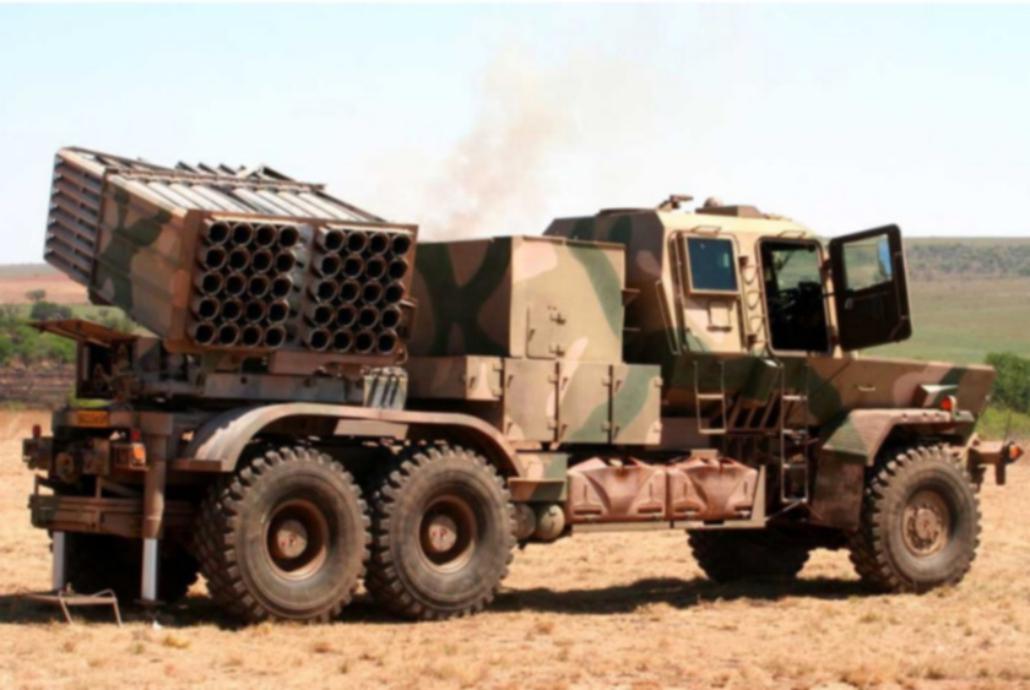
Operational need
It is clear that, after the withdrawal of the Teruel, the Spanish ET needs to acquire new systems for the RALCA no. 63, currently equipped with 155 mm SIAC towed parts. Furthermore, for obvious reasons, these new systems must rise to the occasion, offering the capabilities required of a modern rocket launcher, such as:
- Beat concentrations of unprotected forces such as departure bases, defensive positions, bridgeheads or landing sites, logistics centers, etc.
- Neutralization or prohibition of the use of armored or mechanized forces, hindering or preventing their movement.
- Carry out counterbattery fires.
- Neutralize or prevent the use of anti-tank and anti-aircraft defenses.
- Carry out concealment or blinding fires that cover large areas of the battlefield.
On the other hand, they must offer good performance, having the following characteristics:
- Possibility of hitting distant targets, outside the range of classical artillery (distances greater than 40 km).
- In special cases, using terminal guidance munitions, have great precision to avoid unwanted collateral damage.
- Weight and dimensions that allow easy projection by any means of transportation, including air. Likewise, it must have good speed, mobility and autonomy performance.
- Easy and quick reloading of ammunition, if possible with an automatic loader, and with the use of disposable launchers or not, taking less than 10 minutes.
- Possibility of using rockets of various calibers and features that can also be equipped with different warheads and terminal guidance. In this field, it would be highly recommended to use one or more limited range munitions for instruction and training tasks, in small areas such as maneuver fields. Obviously, the firing tables for those ammunition must also be included in the aiming control systems.
- The cabin must have a modular armor with additional plates, which protect the gunners against direct impacts from light weapons, shrapnel, mines and improvised explosives (IED), as well as explosion-formed penetrators (EFP). Obviously, the different levels of protection will be those considered appropriate by the EME, depending on the type of mission to be carried out; hence, the protection assembly must be modular.
- For self-defense functions, a 12,70 mm heavy machine gun must be mounted on the roof of the vehicle cabin as a basic option, although it would be desirable to integrate a remote control weapons station with the possibility of using 12,70 mm machine guns or 7,62 mm, or a 40 mm automatic grenade launcher. Of course, this RCWS would also be advisable to include a day/night vision set (equipped with TV and thermal cameras), a laser rangefinder and a battery of artifice launchers with the possibility of using different munitions, not just smoke ones for concealment. .
- Finally, they must be able to be used integrated with other Artillery units, through the battlefield management system and, of course, the command and control system (TALOS) and, as far as possible, be interoperable with the equipment used. by the Allied Armies, especially those of NATO.
In general terms, the future rocket launcher system will consist of the following elements: Platform, which should be the same for all elements, based on a truck of those existing in service or planned for the future; launcher or launchers, according to the selection made of disposable or rechargeable models, for rockets of different characteristics, etc.; transport set for ammunition vehicles (crane, supports for the different launchers...); a Fire Control System mounted on a vehicle with a cabin or rear container, for each battery; and a GALCA Command and Control System. In summary, the sets will have to be purchased to complete the GALCA templates:
- 12 launch vehicles to organize three batteries, with as many ammunition vehicles.
- 3 battery fire control vehicles.
- Support sensors (radar, weather station, advanced ground and UAV observers...)
- 1 GALCA command and control vehicle; and, although we assume that they are already integrated into the unit, the auxiliary equipment and vehicles necessary for the group and the batteries (recovery and maintenance, transportation, evacuation of wounded, food and baggage, ammunition, transmissions, etc.).
Obviously, all the command and control systems will be derived from GMV's TALOS, currently used for both artillery and mortars, as well as the battlefield management system, whose adaptation to a rocket launcher should not pose any problem. absolutely.
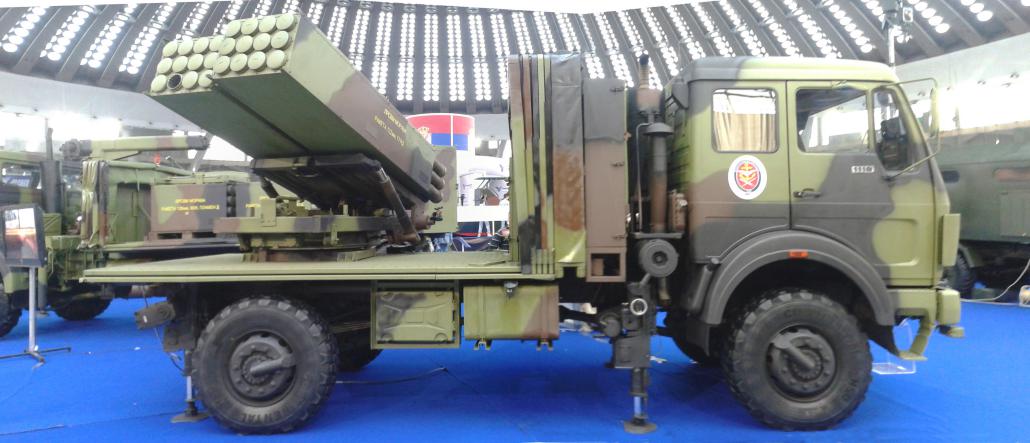
Available options
Basically, there are three possibilities to develop and manufacture the future rocket launcher, or any other weapons system of a certain complexity, namely:
- Develop and manufacture an entirely national model, using one or more Spanish companies. In fact, to replace the Teruel, the Duero and Segovia models were studied, which were finally abandoned.
- Acquire a foreign system already in service, which would be manufactured in its country of origin. For subsequent maintenance or even the manufacturing of ammunition or some elements, a national company could be contracted.
- Finally, select an operating system, with the idea that it will be built for the most part in Spain, counting on one or several Spanish companies that collaborate, according to different agreements or agreements, with the corresponding technological partner. Of course, it must include an acceptable technology transfer, although it is quite likely that the most sophisticated equipment (fire directions, terminal guidance equipment, etc.) will be supplied directly from the company of origin.
The first option, apart from the fact that it would delay the entire program, entails significant technological risks, while requiring large investments in R&D and does not guarantee the achievement of a system of sufficient quality, comparable to that of the main existing systems, therefore that should be discarded.
The second possibility would probably be the simplest and cheapest, but it nevertheless presents some drawbacks, such as the null or reduced presence of Spanish companies in the project, so there would be no technology transfer, as is usually required in projects of a certain size. importance. However, if we carefully analyze the main programs carried out in recent years, such as that of the Leopard 2E car, for example, we will come to the conclusion that the program has become considerably more expensive and lengthened over time but, nevertheless, The much-coveted technology transfer has been conspicuous by its absence. Or, at this point, does anyone believe that in Spain the necessary technology currently exists to develop a car similar to the Leopard? Indeed, the answer is: NOT IN DREAMS.
Consequently, the solution that will be adopted without a doubt will be the last one, that is, that an agreement will be reached by which one or more Spanish companies will sign some type of alliance with the corresponding technological partner, to produce in Spain part of the system components, while the most important ones will be manufactured in the country of origin. Furthermore, given that the future rocket launcher will have a long life cycle, probably more than 25 years, it can be assumed that a good part of the maintenance tasks and equipment, ammunition and other spare parts, will be managed and built in Spain to ensure a certain autonomy of use.
For reasons of time and cost, as we have already said, the first thing that will have to be done is to select a rocket launcher from those currently operational, to later proceed to its production, according to the aforementioned premises. To do this, reviewing the international market, we found a large number of models that could be considered, although many of them we can simply rule out due to their origin or lack of quality, especially with regard to the use of sufficiently precise terminal guidance munitions. . As a simple curiosity, the most notable ones following the alphabetical order of their country of origin are the following: Astros II and Astros 2020 (Brazil); SLM Son of Lightning (Chile/Israel); WS-1/2/6, Type 90B, WM-80/120…(China R.P.); MLRS and HIMARS (USA); Pinaka I/II (India); Lynx (Israel); LAROM (Romania/Israel); BM 21 Grad, BM 27 Uragan, BM 30 Smerch and TOS-1 Buratino (Soviet Union/Russia); Valkiri Mk II (South Africa); M-94 Plamen-S, M-77 Oganj, and LRSVM Morava (Yugoslavia).
Apart from the systems mentioned, there are many others in different configurations, the most numerous being those derived from the Soviet BM-21, which are used by twenty countries around the world, some of which have modernized them or made their own versions. .
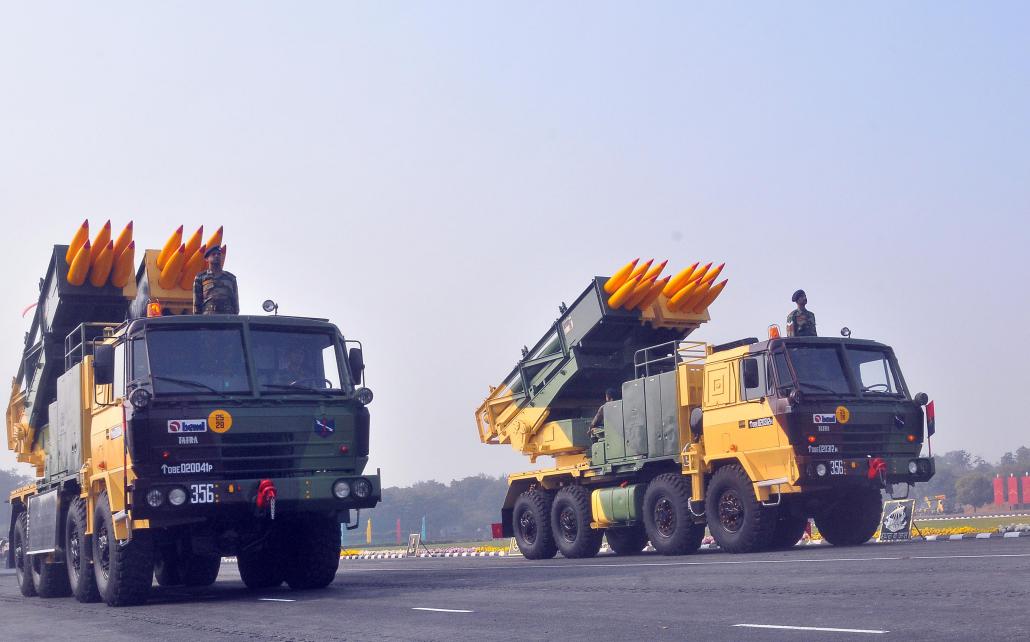
Selected models
According to what has been reviewed so far and the news that has been published so far, it seems that the Spanish Army is considering three systems, namely: Brazilian ASTROS 2020, North American HIMARS and Israeli LYNX. In fact, as has emerged, in 2017 a request for information or RFI was made to the construction companies (Lockheed Martin and IMI) regarding the last two, while, in September 2018, a commission from the Directorate of Acquisitions of the Army Logistics Support Command, to receive information directly from the company Avibras. Consequently, regardless of whether another team is considered later, below we will review the main data of interest of the three mentioned.
ASTROS 2020
The development of field rockets in Brazil occurred in the 60s, the first model being the 108 mm FGT-1RA108, which was acquired by both the Brazilian Artillery and Marine Corps and Iraq. It had a launcher with 16 ramps that was mounted on a light 4×4 vehicle or on a two-wheeled trailer. Later, using that same trailer, the SBAT-70 export model appeared, with a launcher for 36 70 mm air-to-surface rockets, manufactured by Avibras. It was followed by the SBAT-127, also for export and derived from the 127 mm aerial version, but with a 12-ramp launcher that could be installed on a light vehicle or trailer.
After the two systems described, of which we have no evidence that were built in series, some experimental long-range rockets were designed for testing, which served as a basis, already in the 80s, for the definitive development of ASTROS II (Artillery Saturation Rocket System), made at the request of Iraq, which was at war with Iran.
Without a doubt, the ASTROS II is one of the most versatile rocket systems that exist, since it has ammunition of different calibers that can be combined (each of the two launcher modules can carry different rockets), which would allow, for example, firing at near and far targets almost simultaneously. In addition, various warheads are offered that include even bivalent submunitions, anti-tank and counter-personnel. Each module has capacity for the following rockets: 16 SS-30, 8 SS-40, 2 SS-60/80 and 1 SS-150 or AVMT missile. As for the range, this varies between 30 km for the SS-30 and 150 km for the SS-150, not counting the 300 km for the most recently developed AVMT missile.
Although the rockets fired by the original ASTROS II system have a fairly rudimentary terminal guidance system, of an inertial type with trajectory correction, whose CEP or Probable Error Center increases proportionally with the increase in range, the new ASTROS 2020 It has two special munitions (SS-AV-40 and SS-150) that integrate a much more precise GPS terminal guidance system, although it is not entirely clear that its development has been completed, this being a key point when it comes to win the future Spanish contract.
Initially the ASTROS II consists of the following types of vehicles: Universal Multiple Launcher (AV-LMU); Ammunition Resupply (AV-RMD), with two complete reloads and hydraulic cranes; Group Command and Control (AV-VCC); Battery Command and Control (AV-PCC); Fire Control Radar (AV-UCF), optional; Meteorological Station (AV-MET); and several mobile workshops for electronic and mechanical maintenance (AV-OFVE). According to AVIBRAS, a typical ASTROS battery would include: one AV-VPC, six AV-LMU, six AV-RMD, one AV-UCF, and one AV-MET; In addition, at Group level an AV-VCC would have to be added, and three AV-OFVE mobile workshops. Of course, depending on the preferences of each user, there are many other alternatives and possibilities of integrating equipment with different preferences (fire or command directions and battery and group control, radars, weather stations, inertial positioning and GPS, etc.
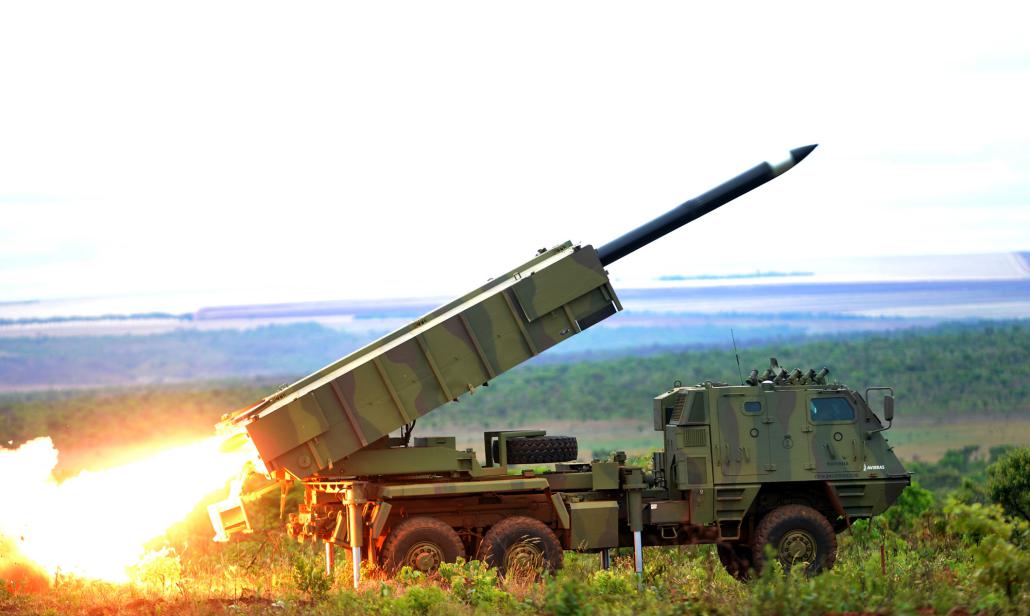
MLRS/HIMARS
In the mid-70s, the US Army began studies on the so-called GSRS (General Support Rocket System), commissioning projects from five companies. After the corresponding tests, the Vought option was selected in 1979, changing the initial name to MLRS (Multiple Launch Rocket System), while it was decided to convert the project into NATO's own weapon.
Using as a platform a chassis derived from the VCI Bradley, the first battery was operational in 1983, at the same time that the European consortium MLRS-Europaische Produktions Gesellschaft GmbH (MLRS-EPG) was created in Munich, which integrated the German companies Diehl, Hunting Engineering ( current Lockheed Martin UK), Aerospatiale (current MBDA) of France, and Italian SNIA BPD. The distribution of manufacturing in different countries was done in accordance with the corresponding orders.
At the end of the 90s, studies began on the new GPS terminal guidance rocket called GMLRS, which began production in 2003 and offers a maximum range of 70 km. Likewise, the development of a new unitary head for this ammunition began, since all the previous ones had heads with submunitions (counterpersonnel - countermaterial, anti-tank terminal guidance, with dispersible AT2 mines...).
Currently, a good part of the MLRS in service have been modernized with the use of new directions of fire with the capacity to fire GMLRS guided munitions and MGM-140 missiles (TACMS II with a 300 km range).
At the end of the 80s, in order to meet the requirements expressed by the North American Army, Lockheed Martin began the development of a more versatile, lightweight system with the possibility of projection, which could be transported on C-130 Hercules aircraft, which culminated in the HIMARS (High-Mobility Artillery Rocket System).
Based on the MLRS, the HIMARS is mounted on a 5-ton truck, so it benefits from greater strategic mobility and speed, while it can be projected over long distances with much greater speed. It was presented in the US in 1993 and, in Europe, during the following year. Already in 1996, the US Army Missile Command signed a contract to build 4 prototypes that were tested over a period of 53 months. Subsequently, at the end of 1999, a new contract was signed for the definitive development of the system, building 6 sets between 2001 and 2002, to carry out final tests and evaluations. Finally, in 2003 the system was admitted for mass production, with the first unit being completed in 2005.
In general terms, the HIMARS can be defined as a simplified MLRS, with a simple launcher for six rockets, which is mounted on a FMTV medium-type truck chassis, in a 6x6 configuration. Furthermore, its late development has allowed it to be equipped with modernized command and control equipment installed on the M-270A1, so that it is capable of firing the same munitions, including GPS terminal guidance and the TACMS or ATACMS missile ( Army TACMS). In summary, these munitions are: M-26 (644/518 M-77/M-85 counterpersonnel-countermaterial submunitions); M-27 and M-28, training inerts; M-31 GMLRS type with unitary warhead and programmable fuze; SCATMIN, with 28 AT2 anti-tank mines; and M-140 TACMS missile, for which a 213 kg unitary warhead is also being studied.
Although the personnel cabin lacks protection, in the Spanish case, which would certainly use another platform, it is not of great importance either. Furthermore, in the United Kingdom several options have been offered, at least two, to provide additional protection kits that would overcome this inconvenience.
Regarding auxiliary systems, the US uses a heavy 8×8 traction truck, while the rest of the countries use various platforms and equipment for each function (direction of fire, command and control, ammunition reloading, maintenance, etc.) .
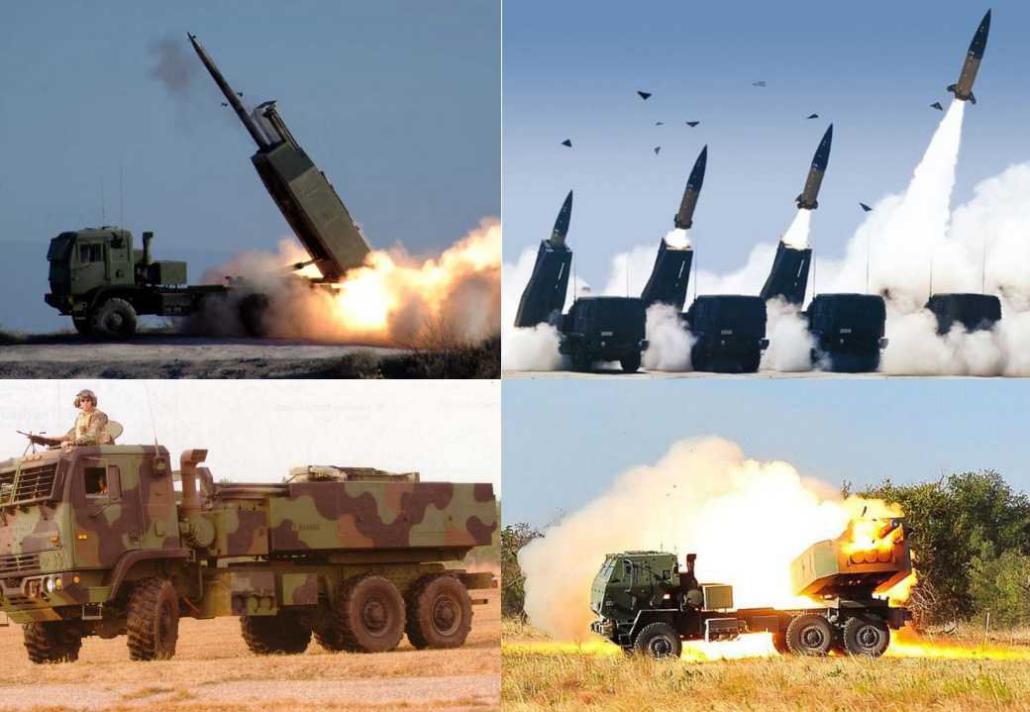
LYNX
This Israeli system undoubtedly has excellent versatility, having a wide variety of rockets and even the Delilah missile, which has been used extensively against Iranian targets in Syria. It is really the evolution of the LAR-160 system designed in the 70s by several companies led by IMI (launchers, mounting and rocket development) and IAI (missiles and guidance systems), initially on AMX-13 light tank chassis. French construction. Since its production began in 1983, it has been continually modernized, giving rise to the current system, apart from the fact that it served as the basis for two mixed models, the SLM Hijo del Rayo made at the request of Chile and the Romanian LAROM. The first was adapted to launch Chilean 160 mm Rayo rockets, as well as the ACCULAR and EXTRA, while the LAROM can use the different 122 mm GRAD models and the LAR-160.
The current LYNX has the following rockets: Russian GRAD and its 122 mm derivatives, 160 mm LAR, 120 or 160 mm ACCULAR, 306 mm EXTRA and 370 mm Predator Hawk, with effective ranges from 20 to 300 km. In addition, it can launch the 330 mm Delilah missile with a 180 km effective range and a CEP of just one meter. Furthermore, a GPS terminal guidance system is offered for ACCULAR, EXTRA and Predator Hawk rockets with a CEP of 10 meters. As far as we know, the Spanish Army showed its initial preferences for the 122 mm ACCULAR and 306 mm EXTRA rockets, with a large part equipped with terminal guidance.
The platform consists of a 6×6 truck configuration, although it is possible to use different 6×6/8×8 models, both for the launchers and for the rest of the system components (munition, command and control, maintenance, etc.) . As for the launcher, it is necessary to highlight that it has two disposable modules, both of which can be combined to use two different rockets at the same time, according to the following capacity per module: 20 GRAD, 11 ACCULAR, 13 LAR, 4 EXTRA/Predator Hawk or 1 Delilah.
The warhead weighs between 20 and 140 kg, and can be unitary with several types of fuzes, have different submunitions or even be penetrating with a delayed explosion, which provides a significant range of possibilities to hit the most diverse targets.
As a guideline, IAI considers that a Lynx Rocket Launcher Group could be made up of the following elements: Group Fire Directorate Center (Command and Control), Meteorological Station, Advanced Fire Observation (3 teams plus another UAV), Radar acquisition and shooting, three Batteries with their Mobile Command Post, 4 Launchers and the corresponding Munitions vehicles, with the capacity to transport 4 ammunition modules of up to 2,7 tons, each. In addition, the necessary maintenance equipment must be included.
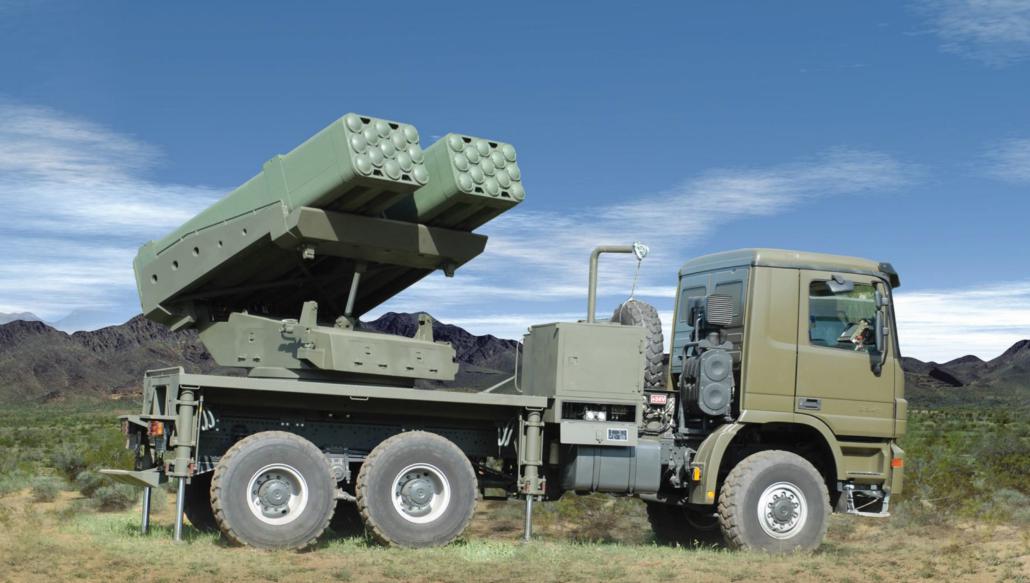
Summary and conclusions
After the withdrawal of the Teruel rocket launchers from service in 2011, the Spanish Army has become one of the few - among those with a certain entity - that does not have any field rocket launcher units.
In 1994, the NORTE Plan contemplated the purchase of the North American MLRS rocket launcher, which was in full swing at that time, and which was also being acquired by the main European armies. However, it soon became clear how difficult it was for Spanish budgets to allow its acquisition, not even to acquire a group of 12 launchers. Although this figure may seem ridiculous to us, if we review the different Defense budgets, we see that it is perfectly justified.
Later, it was decided to acquire the HIMARS system, which can be defined as a simplified version of the MLRS that is installed on a 6×6 truck chassis, which also favors mobility and projection capacity. However, this new option could not be carried out either, so it was temporarily put on hold.
Finally, in recent years the future acquisition has been considered, for which there is still no short-term forecast, of a rocket launcher system, based on one of the models in service, which must be manufactured largely in Spain. To do this, it will be necessary to have the collaboration of some Spanish companies that, according to current regulations, must obtain the corresponding technological transfer. In any case, taking into account that the initial calculations for the 20 or 25 years of the system's life cycle contemplate a cost between €300 and €500 million, I sincerely believe that the definitive purchase is long-term, especially since half Of that cost, at least, it will have to be done in the first years of the program.
Despite the wide variety of existing rocket launchers, it is almost certain that the one finally chosen will be one of the three models discussed in this work (ASTROS 2020, HIMARS and LYNX), which without a doubt can cover the needs of the Spanish Army. However, taking into account the current economic situation, it is quite likely that, regardless of their benefits, what will probably weigh the most will be their total cost, especially if there are large differences between them.
Finally, the agreements between the technology companies will still have to be studied, since according to our news, only IMI has reached an agreement with a Spanish firm, in this case EXPAL, which would be in charge of leading the project. However, this agreement presents a clear drawback, since this last company currently has little sympathy within the MALE, especially after the complaint it filed a few years ago against the officers who selected the Israeli Cardom 81 mm mortar, in to the detriment of the EIMOS which, like it or not, at that time, as one of those officers personally told me, was a mere demonstrator. As if this were not enough, in the field of rockets, MALE wants the company to compensate the Army with several million euros for the non-acceptance of the Teruel M-25 rockets, which could not be used because one exploded inside the launcher. and, since then, no agreement has been reached on the causes of the accident.

Be the first to comment